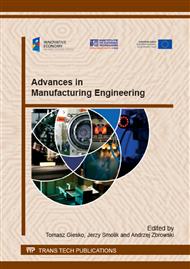p.19
p.27
p.35
p.46
p.54
p.62
p.70
p.78
p.89
Synthesis and Thermal Characterization of Dysprosium Zirconate
Abstract:
Results of investigations related to synthesis and thermal properties analysis of the Dy2Zr2O7 phase was presented in this article. This material was obtained during high temperature synthesis in an actual pressure of 15 MPa, in vacuum of 3×10-6 MPa, and at 1350°C with 2 hours of exposure. Feedstock materials were submicrocrystalline powders of dysprosia Dy2O3 and zirconia ZrO2. Both powders were mechanically blended in alcohol before the sintering process. The final product was analysed from the phase’s composition point of view. It was revealed that main constituent elements were dysprosium zirconate with an overall formula of Dy2Zr2O7 and others were Dy zirconates with a non-stoichiometric character. The presence of zirconia was found with tetragonal types of unite cell. This fact evidences that partial dissolution of Dy2O3 in ZrO2 took place. The obtained material was characterized by calorimetric investigations in the thermal range from 25 to 1450°C.
Info:
Periodical:
Pages:
54-61
Citation:
Online since:
November 2014
Authors:
Keywords:
Price:
Сopyright:
© 2015 Trans Tech Publications Ltd. All Rights Reserved
Share:
Citation:


